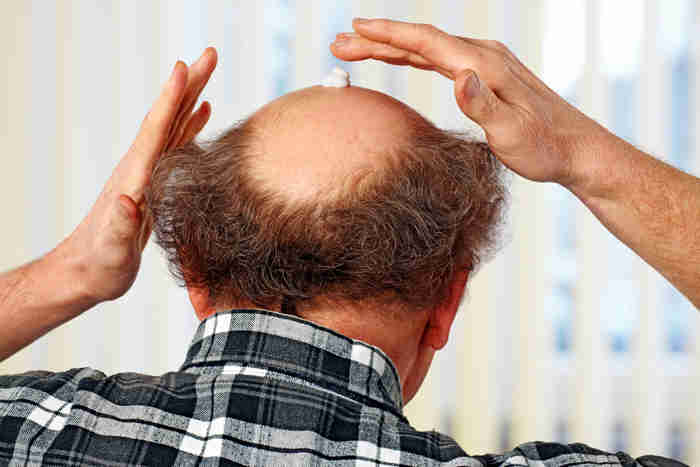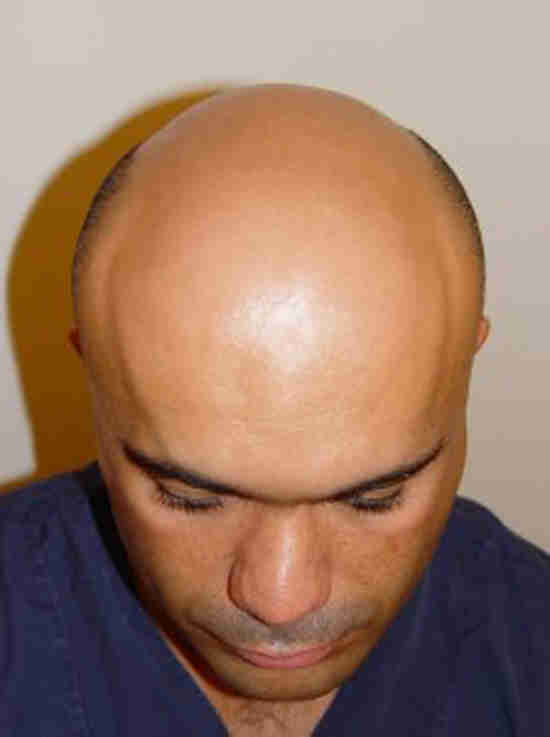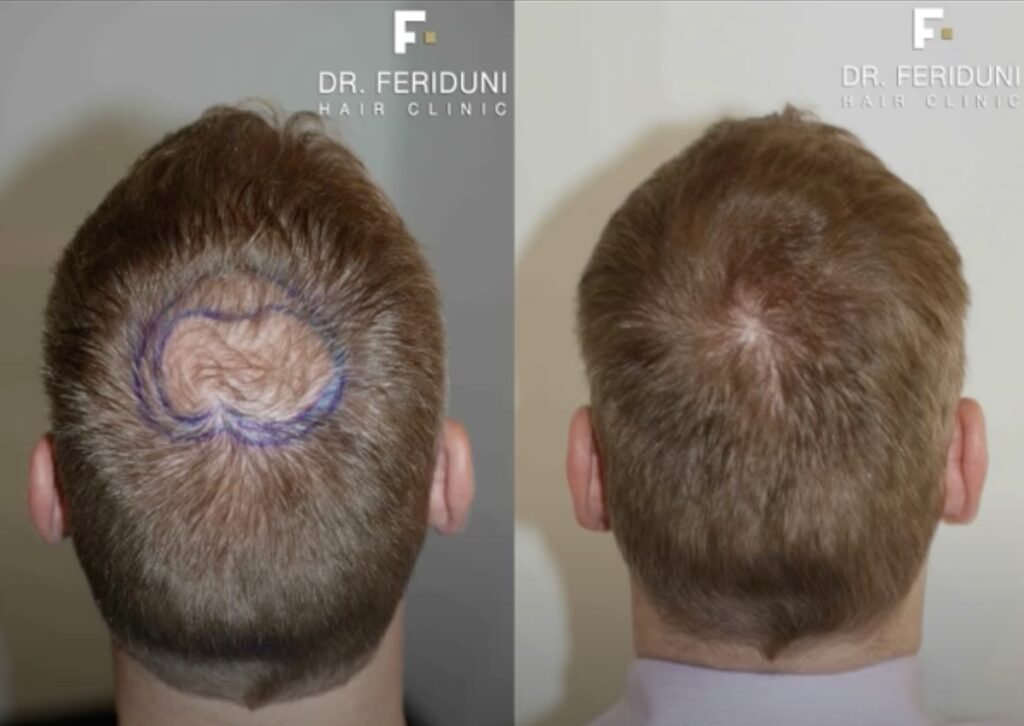
Hair loss, hair loss and the fear of baldness have accompanied people for many centuries, so even today some terms can be traced back to contexts from earlier times.
Hundreds of years ago, in view of the social structures and the serious material differences, people of higher status could at best counteract their dwindling hair by external changes. Completely unwearable by today’s standards, the first wigs were used in those days to enhance one’s status and sovereignty through this hair replacement. The aim was to demonstrate in every respect a personality brimming with repulsiveness; light hair in those days would have expressed illness and weakness. The commoner, however, had no means of enhancing his hair status. However, a crown/vertex or monk’s baldness (hair loss at the back of the head) was hardly perceived as a burden, because all strength and effort was needed in these circles to keep the family alive.
It was to be many years before the male head of hair became relevant in all social classes, the beginnings of this change can be found in religious associations that made the “monk’s bald head” (vertex/crown) a theme.
What is a monk’s bald head?
As in many other areas, the term monk’s baldness can be described with several expressions. In this case, one also speaks of a tonsure with the same meaning. The term monk’s bald head, however, originally refers to a religious background and does not have its origin in the field of hair transplantation.
Many centuries ago, various different religious associations imposed on their followers to shave the top of their heads (sometimes up to the top of the back of the head). This decree is interpreted on the grounds that strict followers of the faith should also present themselves visually as “afflicted with blemishes”, in order to underpin the fact that respectability is not determined by mundane appearances, but exclusively by faith and humility. It was absolutely irrelevant whether the follower of the faith in question actually suffered from hair loss or wore a full hairstyle.
This decree to wear a monk’s hat applied to all followers, but with the restriction: in some religions, this obligation applied only to men of elevated ecclesiastical rank. It was not long ago that the monk’s hat was abolished as a decree, because in fact it was only in 1973 that Pope Paul VI abolished this centuries-old obligation. Today, this historically significant term is used as a synonym for the type of baldness that occurs accordingly. Thus, the term monk’s baldness is mainly used in the field of hair loss and hair transplants.
What is a crown/vertex?

One speaks of a crown when a hair status is present, as already described above. It is therefore a relatively extensive loss of hair at the back of the head, generally also referred to as baldness (colloquially plate). However, in order not to focus too much on the religious significance, as is the case with the term “monk’s baldness”, the term “crown” is often used, especially in the field of hair loss and hair transplantation.
Sufferers of androgenetic alopecia can develop different manifestations and also different patterns of loss. This disease can start with receding hairline and spread steadily over the top of the head, but so-called “islands” can also develop, as is often the case with a typical male pattern of hair loss. Such a pattern forms a tonsure, in which further progression of hair loss and bald patches is usually to be expected. But it is not only this pattern of loss that causes a vertex due to disease.
In women, the course of hair loss is usually somewhat different, often beginning in the crown region. However, as the process progresses, the formation of a crown can also be observed, so that ultimately there is a similar and comparable problem in men and women.
For a long time, it was assumed that hair loss developed differently according to gender and was clearly differentiated from one another. In the meantime, these views have had to be revised, because both women can suffer from androgenetic alopecia, as well as men can show patterns of hair loss that are associated with a diffuse course, as was previously attributed primarily to women. Crowns can therefore affect anyone; gender-specific subdivisions do not come into play here. However, certain proportions do occur, so that it can be deduced: Women with the characteristic pattern of androgenetic alopecia and men with a diffuse course make up the smaller part of those affected. Crowns, however, are found independently in both sexes.
What can women and men do when a crown develops?
A bald vertex on men is, first of all, socially completely unproblematic, because male hair loss has not been a peculiarity for centuries and is therefore quite “socially acceptable”. Only those men who suffer from their dwindling hair, for example because they can no longer meet their personal standards of appearance with a tonsure, look for alternatives. Trying to counteract the rather drastic course of androgenetic alopecia (hereditary hair loss) with medicinal therapies has not proved satisfactory to date.
It may be possible to slow down the progression of hair loss, but no cases have been published in which a tonsure was completely covered with hair again after the application of prescribed medication against hair loss – with a hair status as if nothing had happened. Alternatively, the options of hair transplantation and hair replacement are theoretically available for men as well as for women. If the desire for a hair operation is present in the presence of a pronounced tonsure or even in the case that there is no longer any natural hair in the front area (hairline) (full bald head, except for the ring of hair), the situation is rather unfortunate.
A hair transplant in the presence of a bald vertex or monk’s baldness? Consider the possible future hair loss and a possible NW 6 situation (complete baldness)

It is certainly not impossible to have a hair transplant performed in cases of incipient or progressive baldness (bald vertex). However, in such cases, the procedure is explicitly individual and also varies from doctor to doctor and it is essential to consider the future hair loss and whether the affected person can possibly achieve a NW 6 situation (see above illustration, complete baldness).
In general, it is assumed that a maximum of 50% donor hair (follicular units/natural hair bundles) from the donor area can be used for redistribution by means of hair transplantation in order to avoid excessive thinning in the hair crown. However, this maximum number is often not sufficient in the presence of a full bald patch to acceptably plant all bald patches in the NW 6 case. Hair transplantation has its limits as a hair redistribution and the consequence would be an overall thinning result which could be considered unsatisfactory due to the low density. The density of the hair crown remaining after the removal of donor grafts is of great relevance, because the donor zone should never be completely exhausted. Especially not at a very young age, in order to be able to consider further measures later. Some hair surgeons therefore put the overall aesthetics in the foreground of their efforts and use the justifiable amount of donor material primarily for the front part and the front area of the top of the head or often leave the bald vertex/crown or the monk’s patella untreated for the time being.
To treat a bald vertex/crown at an early stage and if there is a tendency for the affected person to possibly acquire a NW 6 situation in the future, then an adequate, complete density may not be achieved by a hair transplant and there may be distribution problems, precisely and if the affected person actually acquires total baldness in the future. In this case, it is important to look for the best possible acceptable and aesthetically acceptable solution for the patient. Experienced, renowned hair surgeons will always plan holistically and keep all eventualities firmly in mind. Therefore, as a person affected by a crown, you should seek very detailed advice and entrust the planning exclusively to a proven expert in the field of hair transplantation. In this way, you will learn from a qualified expert which options are feasible for a tonsure and what the prognosis for the future can be.
Hair replacement/hairpiece/toupee for a bald vertext/crown or normal baldness
This option is a successful solution for men as well as for women who are affected by a pronounced bald vertex (monk’s baldness) or normal baldness. In this case, hair replacement can be provided with a foil or optional lacemonture and offers the option of being able to adjust the size to the current bald spots. Depending on the progressing hair loss, reordered hair replacement models can not only cover the area to be covered with new hair true to size and exactly, but it is also possible to switch to a material mix if, for example, the front area is also affected. If the front (hairline) is preserved and crown is present, a hair replacement for the top of the head/tonsure/crown area is sufficient.
Monk’s baldness + lost hair replacement in the front: The integrative hair transplant – transplanted hairline in combination with a hair replacement/hairpiece/toupee
In the case of baldness (monk’s baldness + lost hairline in the front), the focus is on a successful forehead line, so that a foil montage is often chosen, at least for this area, in order to make the forehead area as “invisible” as possible, so that third parties cannot see that hair replacement is being used here. However, the hairline often weakens at the front hairline and often hairstyles have to be worn that place the hair in the hairline area forward so that the hairline cannot be “exposed” as artificial and as a hairline. Frequently, however, many hair loss sufferers wish to be able to comb or raise the hair in the front, which, however, can only be offered by modern hair transplantation at the present time.
Alternatively – there is the option of having the front hairline set by means of an autologous hair transplant and starting with the hair replacement directly behind it (to cover the bald crown/monk’s patella). This method of combining hair transplantation and hair replacement (toupee/hairpiece) has only recently been considered.
Whether such a procedure can be considered for the individual case, however, will be determined in the course of a comprehensive consultation with the expert. Only the hair surgeon himself can assess whether the risks of a hair transplant and the existing conditions allow such a solution. However, if you as a man can do without raising the hair on the forehead (styling up/geling up the hairline) and are happy with a little “free style” instead, all options are open to you with hair replacement, both in the front area and for the tonsure, and you can get a very attractive, natural and complete hairstyle with hair replacement – compared to today’s modern products. In this area, too, the quality and aesthetics of the result depend on comprehensive and expert advice. Those affected should therefore always visit several specialist studios for second hair in order to get a personal impression of the materials and the options for their own needs before a rash decision leads to a possibly disappointing result.
Examples of hair transplantation for bald crowns or monk’s baldness
Examples of vertex planting:



